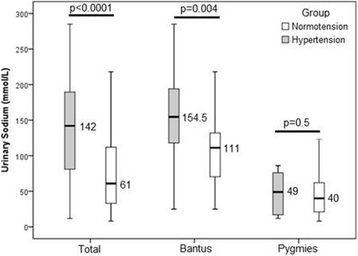Association of urinary sodium excretion with blood pressure and risk factors associated with hypertension among Cameroonian pygmies and bantus: a cross-sectional study
- PMID: 29514623
- PMCID: PMC5842583
- DOI: 10.1186/s12872-018-0787-3
Association of urinary sodium excretion with blood pressure and risk factors associated with hypertension among Cameroonian pygmies and bantus: a cross-sectional study
Abstract
Background: High salt intake increases blood pressure (BP) and hypertension risk. This study aimed to examine association of urinary sodium excretion with BP and hypertension correlates among Cameroonian pygmies under hunter-gatherer subsistence mode and Bantus, living in urban area under unhealthy behavioral habits.
Methods: In this cross-sectional cluster sampling study, we randomly enrolled rural pygmies living in Lolodorf and urban Bantus living in Douala. The World Health Organization steps questionnaire was used to collect socio-demographic and lifestyle data. Height, weight, BP and single overnight spot urine samples were obtained in all participants. BP was measured in triplicate. Urinary sodium and potassium excretion was determined by flame photometry. Data were recorded and analyzed using SPSS 16.0.
Results: We included 150 Pygmies and 150 Bantus aged 38 ± 12 years and 33 ± 11 years, respectively (p < 0.0001). Compare to Bantus, pygmy's height and weight were respectively: 1.54 ± 0.09 m vs 1.72 ± 0.12 m; and 54.4 ± 9.2 kg vs 77.2 ± 14.8 kg, all p < 0.0001. Age-standardized prevalence of hypertension was 3.3% among Pygmies and 28% among Bantus (p < 0.0001). Age-adjusted systolic and diastolic BP were lower in Pygmies than in Bantus (107 ± 12 vs 119 ± 17 mmHg and 71 ± 11 vs 78 ± 13 mmHg respectively, all P < 0.0001). BP increased with age but to a lesser extent in Pygmies (all p < 0.01). Urinary sodium excretion was lower in Pygmies than in Bantus (46.9 ± 32.4 vs 121.5 ± 61.0 mmol/l, p < 0.0001). Systolic and diastolic BP were positively associated with urinary sodium excretion in Bantus (all p < 0.05). In the two groups, urinary potassium excretion was similar, and was not related to blood pressure. In the total study group and in Bantus taken separately, urinary sodium excretion was higher in hypertensive than in normotensive subjects. Multivariable logistic regression showed that urinary sodium excretion, Bantu status and age emerged as independent determinants of hypertension in the whole study group (OR (95%CI): 1.012 (1.005-1.018); 11.408 (3.599-36.165); 1.095 (1.057-1.135) respectively, p < 0.0001).
Conclusion: Hunter-gatherer pygmies exhibit low level of urinary sodium excretion related to low rate of hypertension and slower BP increase with age. Salt intake was a major driver of hypertension in our study population. Our findings highlight the need of efforts to implement nationwide prevention programs promoting risk factor screening and healthier lifestyles including reduction of dietary salt intake in Cameroonian.
Keywords: Bantu; Blood pressure; Hunter-gatherer lifestyle; Hypertension; Pygmy; Urinary sodium excretion.
Conflict of interest statement
Ethics approval and consent to participate
The study was conducted according to the principles of the Declaration of Helsinki and approved by the Douala University Institutional Research on Human Health Ethic Committee (Registry number CEI-UDO/880/11/13). Participation to the study was voluntary and written informed consent was obtained from each participant.
Consent for publication
Not applicable.
Competing interests
The authors declare that they have no competing interests.
Publisher’s Note
Springer Nature remains neutral with regard to jurisdictional claims in published maps and institutional affiliations.
Figures


Similar articles
-
Arterial stiffness and cardiometabolic phenotype of Cameroonian Pygmies and Bantus.J Hypertens. 2018 Mar;36(3):520-527. doi: 10.1097/HJH.0000000000001577. J Hypertens. 2018. PMID: 29035941
-
Prevalence and determinants of blood pressure variability in pygmies of Southern region Cameroon.J Hypertens. 2020 Nov;38(11):2198-2204. doi: 10.1097/HJH.0000000000002529. J Hypertens. 2020. PMID: 32694331
-
Association Between Urinary Sodium and Potassium Excretion and Blood Pressure Among Adults in the United States: National Health and Nutrition Examination Survey, 2014.Circulation. 2018 Jan 16;137(3):237-246. doi: 10.1161/CIRCULATIONAHA.117.029193. Epub 2017 Oct 11. Circulation. 2018. PMID: 29021321 Free PMC article.
-
Effectiveness of self-monitoring devices measuring the urinary sodium-to-potassium ratio, urinary salt (sodium) excretion, or salt concentration in foods for blood pressure management: a systematic review and meta-analysis.Hypertens Res. 2025 Jun;48(6):1891-1898. doi: 10.1038/s41440-025-02124-z. Epub 2025 Feb 13. Hypertens Res. 2025. PMID: 39939826
-
Impact of Salt Intake on the Pathogenesis and Treatment of Hypertension.Adv Exp Med Biol. 2017;956:61-84. doi: 10.1007/5584_2016_147. Adv Exp Med Biol. 2017. PMID: 27757935 Review.
Cited by
-
Associated Factors of Hypertension in Women and Men in Vietnam: A Cross-Sectional Study.Int J Environ Res Public Health. 2019 Nov 26;16(23):4714. doi: 10.3390/ijerph16234714. Int J Environ Res Public Health. 2019. PMID: 31779236 Free PMC article.
-
Preventive Potential of the Aqueous Extract of the Mixture of Bidens pilosa (Asteraceae) and Cymbopogon citratus (Poaceae) Aerial Parts on Hypertension Induced by a Chronic Salt and Alcohol Consumption on the Rats.Evid Based Complement Alternat Med. 2022 Mar 9;2022:1980622. doi: 10.1155/2022/1980622. eCollection 2022. Evid Based Complement Alternat Med. 2022. PMID: 35310038 Free PMC article.
-
Addressing global disparities in blood pressure control: perspectives of the International Society of Hypertension.Cardiovasc Res. 2023 Mar 31;119(2):381-409. doi: 10.1093/cvr/cvac130. Cardiovasc Res. 2023. PMID: 36219457 Free PMC article.
-
Development and validation of processed foods questionnaire (PFQ) in adult inflammatory bowel diseases patients.Eur J Clin Nutr. 2020 Dec;74(12):1653-1660. doi: 10.1038/s41430-020-0632-5. Epub 2020 Apr 22. Eur J Clin Nutr. 2020. PMID: 32322049
-
Cost-effectiveness analysis of population salt reduction interventions to prevent cardiovascular disease in Cameroon: mathematical modelling study.BMJ Open. 2020 Nov 24;10(11):e041346. doi: 10.1136/bmjopen-2020-041346. BMJ Open. 2020. PMID: 33234652 Free PMC article.
References
-
- World Health Organization (WHO). World health statistics: a snapshot of global health 2012 Available at http://www.who.int/gho. Accessed 25 May 2016.
Publication types
MeSH terms
Substances
LinkOut - more resources
Full Text Sources
Other Literature Sources
Medical

